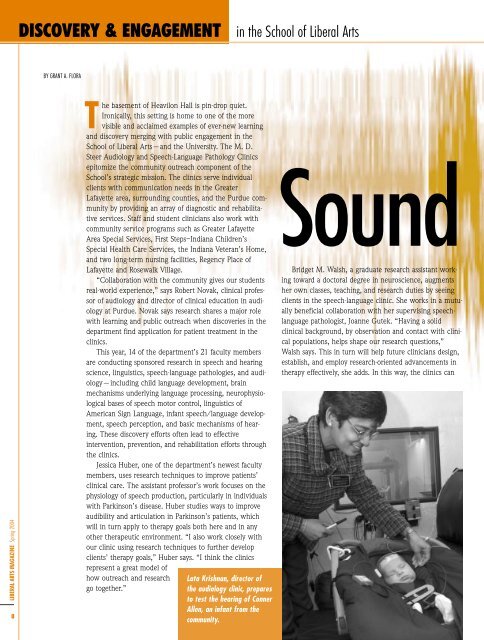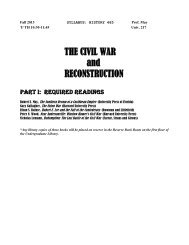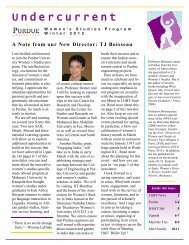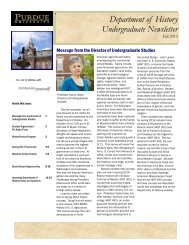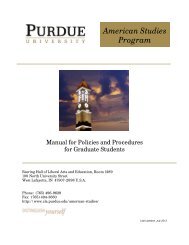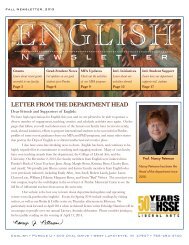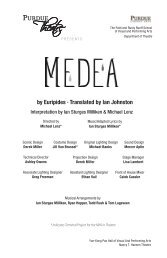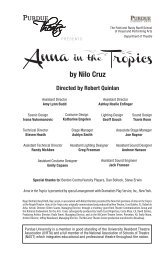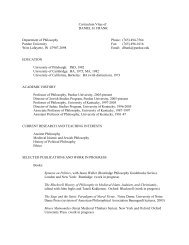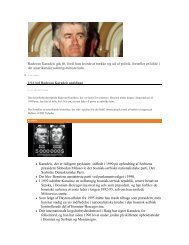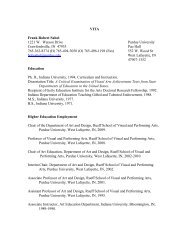Discovery & Engagement Discovery & Engagement
Discovery & Engagement Discovery & Engagement
Discovery & Engagement Discovery & Engagement
Create successful ePaper yourself
Turn your PDF publications into a flip-book with our unique Google optimized e-Paper software.
LIBERAL ARTS MAGAZINE Spring 2004<br />
8<br />
DISCOVERY & ENGAGEMENT in the School of Liberal Arts<br />
BY GRANT A. FLORA<br />
The basement of Heavilon Hall is pin-drop quiet.<br />
Ironically, this setting is home to one of the more<br />
visible and acclaimed examples of ever-new learning<br />
and discovery merging with public engagement in the<br />
School of Liberal Arts—and the University. The M. D.<br />
Steer Audiology and Speech-Language Pathology Clinics<br />
epitomize the community outreach component of the<br />
School’s strategic mission. The clinics serve individual<br />
clients with communication needs in the Greater<br />
Lafayette area, surrounding counties, and the Purdue community<br />
by providing an array of diagnostic and rehabilitative<br />
services. Staff and student clinicians also work with<br />
community service programs such as Greater Lafayette<br />
Area Special Services, First Steps–Indiana Children’s<br />
Special Health Care Services, the Indiana Veteran’s Home,<br />
and two long-term nursing facilities, Regency Place of<br />
Lafayette and Rosewalk Village.<br />
“Collaboration with the community gives our students<br />
real-world experience,” says Robert Novak, clinical professor<br />
of audiology and director of clinical education in audiology<br />
at Purdue. Novak says research shares a major role<br />
with learning and public outreach when discoveries in the<br />
department find application for patient treatment in the<br />
clinics.<br />
This year, 14 of the department’s 21 faculty members<br />
are conducting sponsored research in speech and hearing<br />
science, linguistics, speech-language pathologies, and audiology—including<br />
child language development, brain<br />
mechanisms underlying language processing, neurophysiological<br />
bases of speech motor control, linguistics of<br />
American Sign Language, infant speech/language development,<br />
speech perception, and basic mechanisms of hearing.<br />
These discovery efforts often lead to effective<br />
intervention, prevention, and rehabilitation efforts through<br />
the clinics.<br />
Jessica Huber, one of the department’s newest faculty<br />
members, uses research techniques to improve patients’<br />
clinical care. The assistant professor’s work focuses on the<br />
physiology of speech production, particularly in individuals<br />
with Parkinson’s disease. Huber studies ways to improve<br />
audibility and articulation in Parkinson’s patients, which<br />
will in turn apply to therapy goals both here and in any<br />
other therapeutic environment. “I also work closely with<br />
our clinic using research techniques to further develop<br />
clients’ therapy goals,” Huber says. “I think the clinics<br />
represent a great model of<br />
how outreach and research<br />
go together.”<br />
Lata Krishnan, director of<br />
the audiology clinic, prepares<br />
to test the hearing of Conner<br />
Allen, an infant from the<br />
community.<br />
Sound<br />
Bridget M. Walsh, a graduate research assistant working<br />
toward a doctoral degree in neuroscience, augments<br />
her own classes, teaching, and research duties by seeing<br />
clients in the speech-language clinic. She works in a mutually<br />
beneficial collaboration with her supervising speechlanguage<br />
pathologist, Joanne Gutek. “Having a solid<br />
clinical background, by observation and contact with clinical<br />
populations, helps shape our research questions,”<br />
Walsh says. This in turn will help future clinicians design,<br />
establish, and employ research-oriented advancements in<br />
therapy effectively, she adds. In this way, the clinics can


